Your steel mill works hard to produce perfect coils. They leave the production line with a flawless finish. But then, a customer calls. The shipment arrived with scratches, dents, or signs of rust. This is a frustrating and expensive problem. Each damaged coil represents a direct loss. It's not just the cost of scrap or rework. It's the wasted energy, the lost production hours, and the complex logistics of managing a return. For a steel mill owner in a competitive market like Thailand, these costs eat directly into your profits and damage the reputation you've worked so hard to build. The problem is that small, overlooked issues in your packing process are creating these large, unacceptable losses.
To minimize coil damage in Thai steel plants, you must replace inconsistent manual packing with automated wrapping systems. These systems apply protective materials with uniform tension and coverage. You also need to integrate proper coil handling equipment, like coil cars and tilters, to prevent physical impact before and after wrapping.
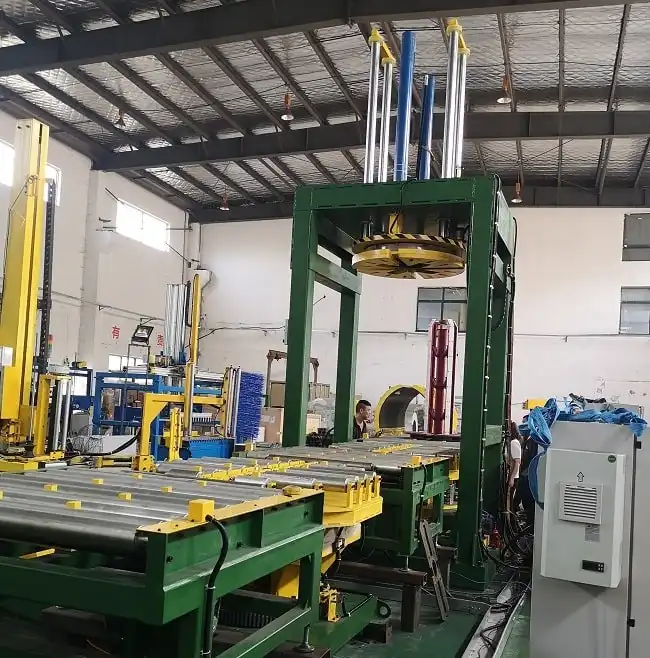
This approach sounds simple, but the real success is in the details. I have spent my entire career in this industry. I started as an engineer on the factory floor and eventually built my own packing machine company. I've seen firsthand how a well-designed packing system can transform a plant's profitability. It's not about one machine; it's about the entire process. Let's break down the key areas where you can make changes that will protect your coils and your bottom line.
Why is Manual Packing a Hidden Cost Driver for Coil Damage?
You might see manual packing as a flexible, low-overhead solution. Your team can adapt to different coil sizes easily. However, this flexibility comes at a cost. Your workers are human. They get tired throughout a long shift. Their skill levels vary. The way a coil is wrapped on a Monday morning is often very different from how it's wrapped on a Friday afternoon. This inconsistency is a major source of hidden costs.
Manual packing is a hidden cost driver because it lacks consistency and precision. Human error leads to uneven tension, gaps in coverage, and improper material use. This results in inadequate protection against moisture, corrosion, and physical impacts during transit, causing costly damage and customer rejections.
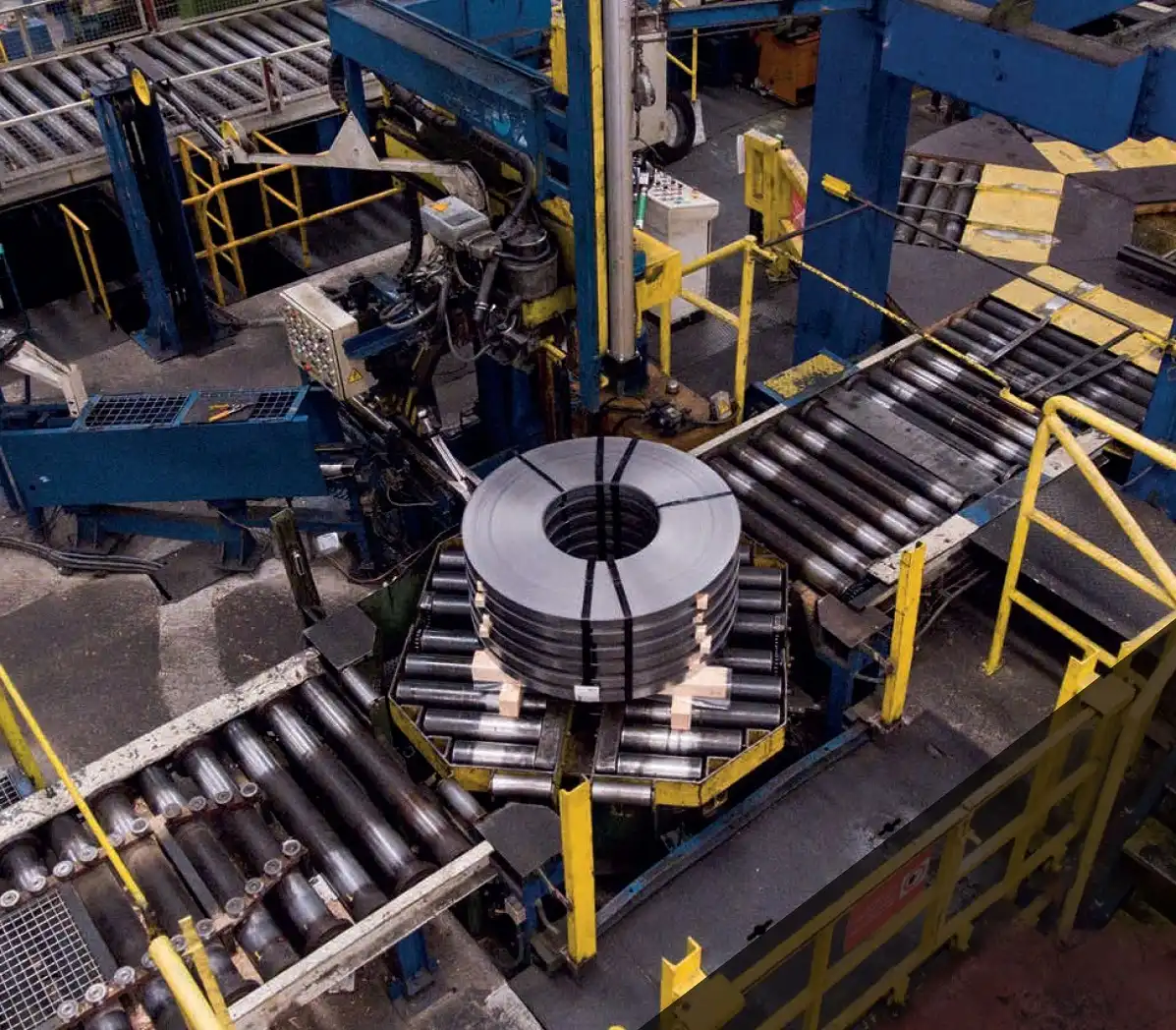
Let's dive deeper into why this manual process, which seems simple on the surface, is often the root cause of significant financial losses. The issues go beyond just a poorly wrapped coil; they affect your material costs, worker safety, and overall operational efficiency.
The Inconsistency of Human Labor
The single biggest issue with manual packing is the lack of repeatability. An automated wrapper performs the exact same cycle with the exact same parameters every single time. A human cannot. A new employee may wrap a coil too loosely, leaving it vulnerable. A seasoned veteran, trying to work quickly, might pull the film too tight and cause it to tear. This variability means you have no reliable standard for quality control at one of the most critical stages of your process – the final packaging. When a customer receives a damaged coil, it's nearly impossible to trace the root cause back to a specific wrapping technique used on a particular day. You are left with a recurring problem but no clear data on how to fix it. This inconsistency makes your entire quality assurance effort a matter of guesswork.
Material Waste and Inefficiency
In my experience visiting countless steel plants, I've noticed two common scenarios with manual wrapping. Either workers use far too much packing material to "be safe," or they use too little to save time. Both are costly. Using excess stretch film or VCI paper on every coil adds up to a significant material cost over a year. An automated wrapper with a pre-stretch carriage can use up to 300% less film to achieve a stronger, more secure wrap. Conversely, skimping on material to speed up the process creates weak spots in the packaging. These spots allow moisture to penetrate, especially in Thailand's humid climate, leading to corrosion and customer claims. A machine applies the precise, optimized amount of material every time, cutting waste while guaranteeing protection.
Safety and Ergonomic Risks
We must also consider the physical toll on your employees. Manually wrapping large, heavy steel coils is physically demanding work. Workers are constantly lifting heavy rolls of packing material, bending in awkward positions, and walking around the coil hundreds of times per shift. This leads to a high risk of repetitive strain injuries, back problems, and fatigue. An injury not only impacts the well-being of your employee but also leads to lost time, potential compensation claims, and a need to train replacement staff. An automated system removes these ergonomic risks. The operator becomes a supervisor of the process, not the source of manual labor, creating a safer and more stable work environment.
| Factor | Manual Packing | Automated Packing |
|---|---|---|
| Labor Cost | High, ongoing, and subject to wage increases and turnover. | Low, primarily consists of routine maintenance by trained staff. |
| Material Usage | Inconsistent. Often high due to guesswork and waste. | Optimized and consistent. Can reduce film costs by over 50%. |
| Damage Rate | Higher and unpredictable. Leads to costly customer claims. | Significantly lower and predictable, ensuring product integrity. |
| Throughput | Limited by worker speed and endurance. A clear bottleneck. | High, consistent, and matched to your production line's speed. |
| Safety Risk | High due to ergonomics, repetitive motion, and heavy lifting. | Minimal, as operators are removed from physically demanding tasks. |
How Can Automated Wrapping Machines Protect Coils More Effectively?
You have invested millions of dollars in furnaces, casters, and rolling mills to produce top-tier steel. Yet, the final step of protecting that valuable product is often where the system breaks down. A single coil damaged in transit can erase the profit from an entire batch. Relying on an inconsistent manual process is like building a strong fortress but leaving the main gate unlocked. Every shipment becomes a gamble against rough handling, bumpy roads, and corrosive humidity.
Automated wrapping machines protect coils more effectively by applying packing materials like stretch film and VCI paper with precise, consistent tension and overlap. This creates a uniform, sealed barrier against moisture, dust, and physical damage. The process is repeatable and programmable for different coil sizes, eliminating human error.
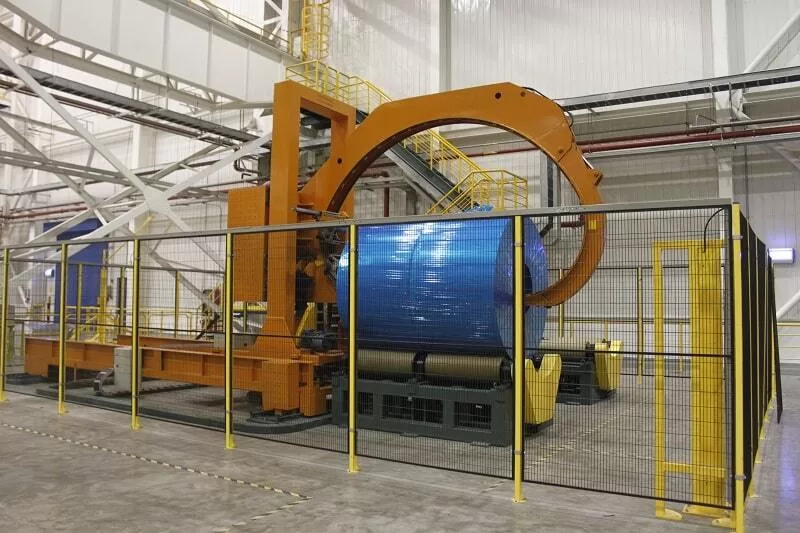
An automated wrapper is not just a machine that spins film around a coil. It is a piece of precision engineering designed to solve specific problems. It applies scientific principles to create a protective package that is both cost-effective and highly resilient. Let's look at the specific features that make this technology so effective.
The Science of Tension and Overlap
The secret to a strong, effective wrap lies in two key parameters: tension and overlap. Modern automated wrappers use a powered pre-stretch carriage. This device stretches the film by 200-300% before it is applied to the coil. This process does two things. First, it aligns the molecules in the film, dramatically increasing its tensile strength and puncture resistance. Second, it means one meter of film from the roll becomes three or four meters of applied film, drastically cutting your material consumption and cost. This is a direct benefit to your bottom line. The machine's PLC (Programmable Logic Controller) also precisely controls the overlap of each layer. A 50% overlap is standard, which means every part of the coil is covered by at least two layers of film. This creates a watertight seal that is nearly impossible to achieve manually, providing superior protection against moisture and corrosion.
Material Integration for Total Protection
Different shipping conditions require different types of protection. A coil shipped domestically might only need stretch film. A coil being exported by sea freight through a humid port like Laem Chabang needs much more robust protection. Modern orbital wrappers are designed to be versatile. They can be configured to apply multiple layers of different materials in a single, automated cycle. For example, the machine can first apply a layer of VCI (Volatile Corrosion Inhibitor) paper, which releases a harmless vapor that prevents rust. Then, it can apply a layer of stretch film to create a waterproof barrier. For extra protection against physical impact, a layer of kraft paper or plastic sheeting can be added. The machine applies each layer perfectly, creating a multi-layered defense system tailored to the coil's specific journey.
Customization for Different Coil Types
Your steel mill produces a variety of products. You might have narrow slit coils and wide master coils. An automated system can handle this variability with ease. You can save different "recipes" in the machine's HMI (Human-Machine Interface). Recipe 1 might be for a 1500mm wide master coil, using 10 wraps of VCI paper and 20 wraps of stretch film. Recipe 2 could be for a 300mm wide slit coil, requiring only stretch film. The operator simply selects the correct program, and the machine adjusts its parameters automatically. This ensures that every single product receives the exact level of protection it needs, without waste and without error. This level of precision and customization is simply not possible with manual packing.
| Feature | Description | Benefit for Your Steel Mill |
|---|---|---|
| Programmable Logic Controller (PLC) | The central computer that controls all machine functions. | Guarantees consistent quality, allows for recipe management, and simplifies operation. |
| Powered Pre-stretch Carriage | Stretches the film before it's applied to the coil. | Reduces film consumption by up to 300%, directly lowering your operational costs. |
| Variable Speed Controls | Controls the rotation speed of the ring and conveyors. | Ensures the correct film overlap is maintained for a perfect, secure wrap. |
| Automatic Cut & Clamp System | Automatically cuts the film and holds it for the next cycle. | Improves safety for operators and increases the line's overall throughput and efficiency. |
What's the Role of Proper Coil Handling and Conveying in Damage Prevention?
Imagine you have just installed a brand-new, state-of-the-art orbital wrapping machine. You are confident that your packing issues are solved. But a month later, you are still getting reports of dented edges and surface scratches on your coils. What went wrong? The reality is that damage often occurs long before the coil ever reaches the wrapping station. A moment of carelessness with a forklift, an improper lift with a C-hook, or a coil bumping into another on the shop floor can cause irreparable damage. Your new wrapper is just perfectly preserving a product that was already compromised.
Proper coil handling and conveying prevent damage by minimizing human interaction and physical impact. Automated systems like coil cars, tilters, and conveyors move coils smoothly and securely from the production line to the packing station and into storage, eliminating the risks associated with forklifts and cranes.
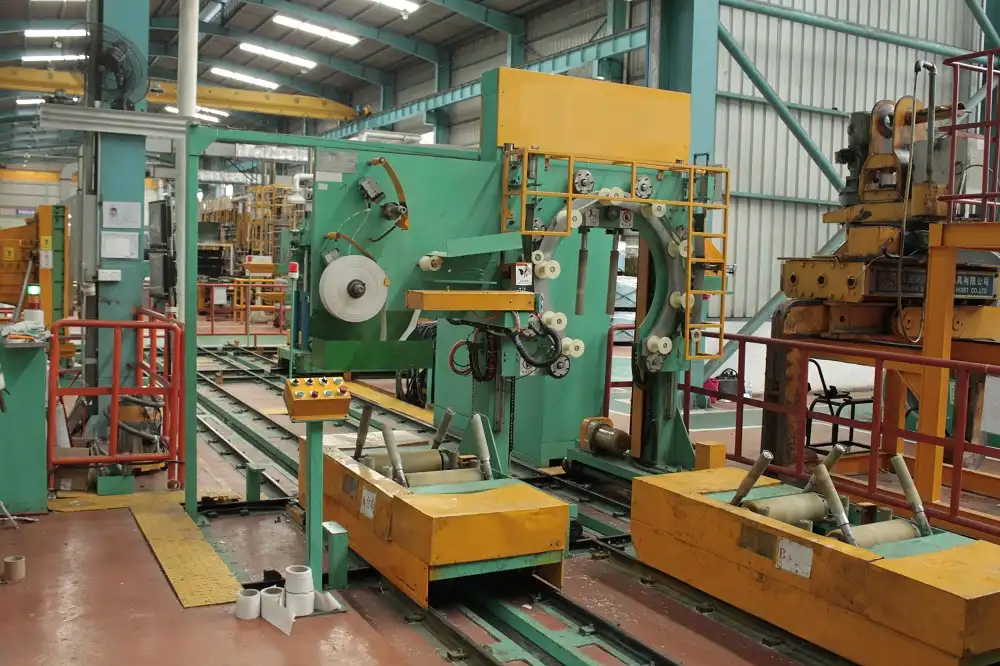
A truly effective solution is a system. It’s about creating a seamless, gentle, and automated journey for the coil from the moment it leaves the recoiler until it is safely loaded for shipment. The handling equipment is not an accessory; it is a core component of your quality control process.
From Production to Packing: The Critical Journey
Let's trace the ideal path of a steel coil through an automated system. Once the coil is complete at the recoiler, it is pushed onto a coil car. This car safely transports it from the production line to the start of the packing line, avoiding any risk of collision. If the coil is in an "eye-to-the-sky" orientation, a coil tilter or downender gently rotates it 90 degrees to an "eye-to-the-wall" position, ready for wrapping. This single machine eliminates one of the most common sources of damage: flipping coils with a crane. From the tilter, the coil moves onto a powered conveyor system. This system smoothly transports it to the centering station in front of the wrapper, then through the wrapper, and finally to a strapping and weighing station. Each step is controlled, gentle, and free from the jolts and impacts of manual handling.
Eliminating the Forklift Factor
In my experience, the forklift is the number one enemy of a perfect steel coil. While necessary in some parts of a plant, they are a significant liability around the packing area. A driver might be distracted for a second. The forks might not be perfectly aligned. The result is a deep gouge or a crushed edge on a multi-thousand-dollar coil. An integrated conveyor system completely removes this risk factor from the packing process. The movement is predictable, the speed is controlled, and there are no sharp metal forks coming into contact with your product. By automating this movement, you are directly reducing your damage rates and the associated costs.
System Integration for Seamless Flow
The true power of this approach comes from system integration. The individual components—coil car, tilter, conveyors, wrapper—are all connected and communicate with each other. Sensors detect when a coil has arrived from the production line. The coil car then automatically moves it to the conveyor. The conveyor starts and moves the coil to the wrapper. The wrapper's sensors detect the coil's presence and diameter, then initiate the correct wrapping program. This creates a continuous, automated flow of product. It eliminates bottlenecks, reduces manual coordination, and significantly increases the throughput of your packing area. This level of efficiency is crucial for meeting your production targets and improving overall plant productivity.
| Handling Method | Risk of Damage | Efficiency | Integration Potential |
|---|---|---|---|
| Forklift | High. Prone to edge damage, dents, and operator error. | Low. Dependent on operator skill and availability; creates bottlenecks. | Poor. A manual process that is difficult to integrate into an automated line. |
| Overhead Crane (C-Hook) | Moderate. Can damage the inner and outer wraps of the coil if not used carefully. | Moderate. Can be a major bottleneck for the entire production line. | Limited. Requires manual coordination between crane and floor operators. |
| Integrated Conveying System | Very Low. Provides smooth, controlled, and gentle movement. | High. Enables continuous, predictable flow and high throughput. | Excellent. Designed for full integration with MES and packing equipment. |
How Does Integrating Packing Data with MES Improve Quality Control?
You have now automated your handling and wrapping processes. Your damage rates have plummeted. But how do you take the next step? How do you move from simply preventing damage to having complete visibility and control over your entire packing operation? If a customer does have an issue, can you trace that specific coil back to the exact moment it was packed and see all the relevant data? Without data, you are still operating with blind spots.
Integrating packing data with your MES (Manufacturing Execution System) improves quality control by creating a digital record for every coil. It links the coil's production data (heat number, weight, dimensions) with its specific packing data (wrapping program used, material consumption, date/time). This traceability allows for rapid root cause analysis of any damage claims.
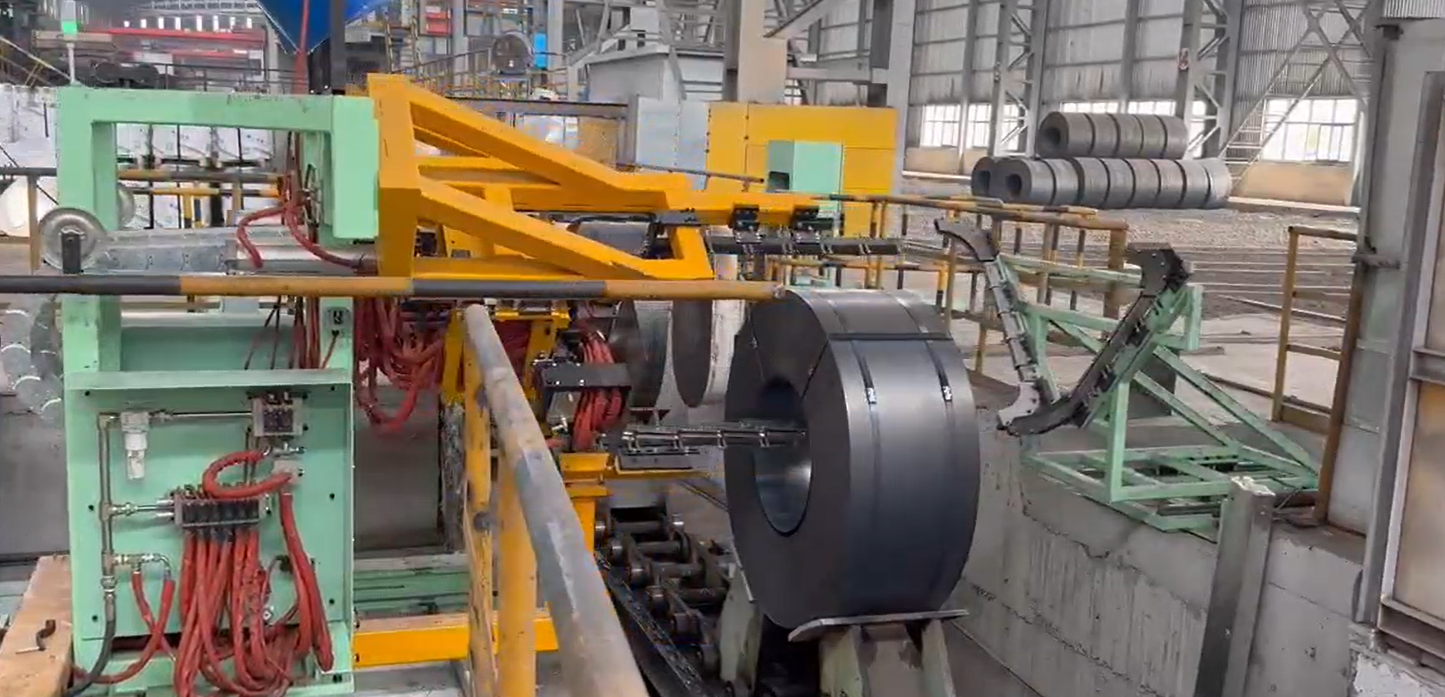
This is the core of digital transformation for your packing line. It's about turning your equipment from standalone machines into intelligent data-gathering nodes in your plant-wide network. This provides the insights you need for true continuous improvement and is a key step towards building a smart factory.
The Power of Traceability
Let's consider a practical example. A customer in Germany calls to report surface corrosion on a coil they received. With a fully integrated system, you don't have to guess what happened. You can enter the coil ID number into your MES. Immediately, you see all the data. You see its production date, its exact chemical composition, and its weight. You also see that it was packed on a specific date and time, by a specific machine, using "Wrapping Program C" (designed for long-distance sea freight). You can see the VCI paper lot number and the stretch film lot number that were used. You can even see that the machine's sensors registered the correct film tension and overlap. With this data, you can quickly determine if the issue was with the packing process, a bad batch of packing material, or something that happened after it left your facility. This is the power of complete traceability.
From Data to Actionable Insights
This data is not just for investigating problems. It is a powerful tool for proactive improvement. By analyzing the data over time, your quality team can identify trends. For example, you might discover that coils wrapped with a specific type of VCI paper have a slightly higher rate of corrosion claims when shipped to tropical climates. This data allows you to make an informed decision to switch suppliers or change the packing recipe for those destinations. You are no longer relying on anecdotes or intuition; you are making data-driven decisions that improve quality and reduce costs.
Enabling Predictive Maintenance
One of the biggest challenges with aging equipment is unexpected downtime. A breakdown on the packing line can bring your entire production to a halt. Modern packing machines are equipped with numerous sensors that monitor their own health. They track motor amperage, cycle counts, film break frequency, and other key performance indicators. When this data is fed into your MES, you can implement a predictive maintenance strategy. The system can automatically generate a work order when a motor's power draw starts to trend upward, indicating it needs service before it fails. This shifts you from a reactive maintenance model to a proactive one, helping you achieve higher equipment uptime and greater production stability.
| Data Point | Source | Value / Action |
|---|---|---|
| Coil ID / Heat Number | MES / Production Line | Links all packing data to a specific, unique product for full traceability. |
| Wrapping Program Used | Packing Machine PLC | Confirms that the correct, pre-defined packing procedure was followed. |
| Material Consumption | Packing Machine Sensors | Tracks material costs per coil, monitors efficiency, and flags anomalies. |
| Cycle Time | Packing Machine PLC | Measures throughput in real-time to identify and resolve bottlenecks. |
| Fault Codes / Alarms | Packing Machine PLC | Enables rapid troubleshooting and provides data for predictive maintenance analysis. |
My Insight: Don't Just Buy a Machine, Invest in a Process
Early in my career, I sold a state-of-the-art orbital wrapping machine to a large steel processor. It was the best machine on the market. A month later, the plant manager called me, and he was angry. "Vincent," he said, "we are still getting complaints about damaged coils. Your machine isn't working." I was worried, so I flew to his plant the next day.
I watched the operation. The wrapping machine was working perfectly. It was applying the film with precision and consistency, just as it was designed to do. But then I saw the problem. To load the coil onto the packing line, they were using a 20-year-old forklift with bent forks. Every time the operator picked up a coil, the tip of the bent fork was putting a small dent in the coil's edge. The wrapper was then flawlessly preserving this damage.
That day I learned one of the most important lessons of my life. It was not enough to sell a great machine. To truly solve a customer's problem, you have to understand their entire process. The problem wasn't the wrapping; it was the handling. This experience is why our slogan at SHJLPACK is "TOTAL SOLUTION FOR WRAPPING MACHINE." We don't just sell you equipment. We look at your entire workflow—from the moment the coil leaves the recoiler to the moment it's loaded onto a truck. We partner with you to design a complete system that addresses your specific challenges. Because protecting your product requires more than just a machine; it requires a thoughtful, integrated process.
Conclusion
Minimizing coil damage requires a system-wide approach. By combining automated handling, precision wrapping, and data integration, you protect your product, cut costs, and build a stronger, more profitable business.





